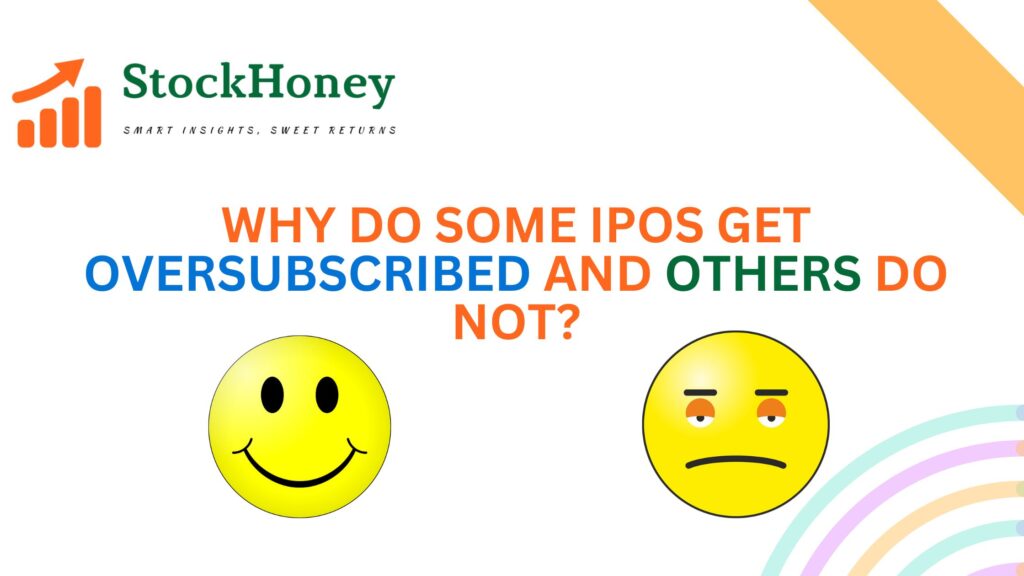Initial Public Offerings, or IPOs, in India, have been hitting the headlines in recent years. Most issues of companies like Zomato, Nykaa, and Paytm did garner huge interest from retail and institutional investors. However, not all IPOs are the same and fetch the same kind of attention. Sometimes, an issue is subscribed multiple times on day one or even in hours, while others do not receive the same enthusiasm. What is the reason behind this? Why does one IPO become a hot ticket, while another goes unnoticed?
In this article, the various factors leading to an over-subscription of an IPO in India will be looked at in relation to the company’s reputation, market sentiment, pricing strategy, and other critical issues that determine investor interest in an IPO.
Understanding IPO Over-Subscription
Before we go to the details, let us first understand what the oversubscription of an IPO means. When an IPO is launched, a certain number of shares are made available to the public. If demand for such a number of shares turns out to be higher than the supply, then it is said to be “oversubscribed”. The extent of oversubscription may vary from very moderate to extreme, and in some cases, it may be several times oversupply, thereby indicating immense interest from investors.
Oversubscription generally tends to indicate that investors are highly interested in the company issuing the IPO and have great confidence in the company. Oversubscription is generally associated with short-term gains because high demand can lead price increase on the listing day.
Factors contributing to the oversubscription of an IPO
Many factors determine whether the IPO will be able to generate interest among the investors and whether that interest will lead to the IPO being oversubscribed. Let us discuss those factors.
Company Reputation and Brand Value
The company’s reputation and brand value are two of the most crucial factors that determine whether the IPO will be a hit or a miss. Well-known brands with good image, coupled with their performance history are able to attract greater public attention. For example, companies like TCS and LIC were able to generate enormous interest during their respective IPOs due to their brand value and credibility.
Key Insight: Companies that have a track record of financial stability and good governance structures in place carry greater credibility and trust among the public. This in turn reduces the perceived risk bout these companies and attracts investors to such companies.
Market Conditions
Market condition is another factor that influences the IPO. In a bullish trend, investors are more confident about the growth prospects and are willing to take more risks. IPOs during a bullish market trend have shown to attract greater participation from investors. On the other hand, during a bearish phase, investors are cautious about making new investments, which may lead to a decrease in IPO subscriptions.
Key Insight: Favorable market conditions generate a positive outlook among investors, increasing the likelihood of IPO oversubscription.
Pricing of the IPO
The issue price set by the company could potentially make or break an IPO. If the price of the IPO is perceived to be too high the investors will hesitate to subscribe for the IPO. However, if the price is attractive and perceived as undervalued then it will attract the investors and the demand for the IPO will increase.
Key Insight: An IPO priced reasonably will attract investors and increase subscription levels. However, an issue priced too high may turn away the investors who would have otherwise purchased the IPO.
Financial Performance and Growth Potential
Investors are attracted to companies with steady growth, profits, and positive cash flow. Additionally, if the company is from a high-growth sector like tech or renewable energy, it may attract more attention. Some of these companies may not be profitable at the time of going public but due to their large user base, brand value, and potential growth prospects make them attractive to investors. Examples Zomato, Swiggy, Nykaa.
Key Insight: Strong finances and promising growth make an IPO more appealing, increasing the subscription rates.
Confidence of Promoter and Institutional Investors
If the promoters or major shareholders continue to hold a significant part of the company’s equity post-IPO, it means they have confidence in the company’s future growth prospects. Additionally, if HNIs and QIBs are investing in the IPO it means the company’s financials and other growth factors have been thoroughly vetted by them and are confident about the company’s future.
High participation from institutions in the IPO may sometimes induce strong demand from retail investors, creating a domino effect, thus leading to oversubscription.
Key Insight: Promoter confidence and institutional backing provide investors with assurance, thereby increasing the chances of oversubscription.
Sector Appeal and Economic Trends
Another factor that would influence subscriptions for an IPO will be the industry or sector the company operates within. Information Technology, health care, and renewable energy are very attractive because they have good future prospects and are relevant in today’s economy. On the other hand, less attractive sectors might not gain much enthusiasm.
When the economic conditions are favorable towards a particular sector, companies operating within that sector attract greater investor attention. For example, during the COVID-19 pandemic, there was heightened demand for IPOs from the technology and healthcare sector due to their essential nature in the pandemic response.
Key Insight: An IPO becomes more attractive when the sector is relevant and the economic trend is favorable, resulting in oversubscription.
Marketing and Promotion of an IPO
Marketing and promotion do play a significant role in making the investors aware of the IPO. A well-marketed and promoted IPO can attract a large number of potential investors. Companies going public often use print media, social media, and financial news channels to reach retail investors.
If the company, with the IPO, can effectively educate investors about its growth potential. It can create greater excitement about the IPO, which may lead to oversubscription.
Key Insight: Effective marketing can attract more retail investors, thereby increasing the chances of IPO oversubscription.
Effect of IPO Oversubscription on Investors
If the IPO is oversubscribed the shares are allocated by a lottery system, which means all the applicants for the IPO will not receive the shares. Oversubscription often leads to a listing day premium, which means the share price on the listing day is higher than the issue price, giving the investors the chance for a quick gain.
Examples of Oversubscribed IPO in India.
Here are a few recent examples of oversubscribed IPOs in India.
- Zomato IPO: The IPO was oversubscribed 38.25 times
- Nykaa IPO: It was oversubscribed nearly 82 times
- LIC IPO: Though only modestly oversubscribed, the brand value and reach of LIC made it very enticing for a retail investor.
The above-discussed factors contributed to making the above IPOs a hit with investors.
Conclusion
Several factors contribute to an IPO getting oversubscribed. Companies having sound fundamentals, brand names, attractive pricing, and favorable market conditions have a high chance of getting their issue oversubscribed. Companies that have growth prospects with an effective promotion strategy also draw investors’ attention.
Understanding the factors that result in an IPO being oversubscribed; can help an investor make the right decision. Please remember, that oversubscription indicates popularity and does not guarantee returns. As an investor, it is important to conduct thorough research before participating in an IPO. The best starting point is going through the company’s DRHP available on the SEBI website.
Happy IPO Investing!
Related Information & Articles
Current & Upcoming IPOs in India
What IPO Subscription Status Reveals?
Master How To Value A Company Before Investing in an IPO
IPO Success – 5 Important Factors To Consider


